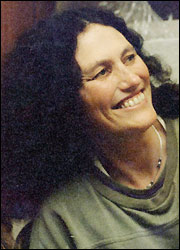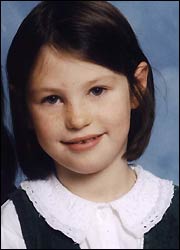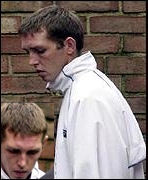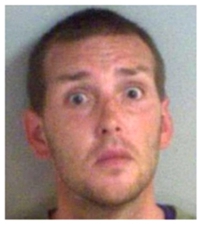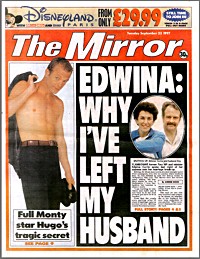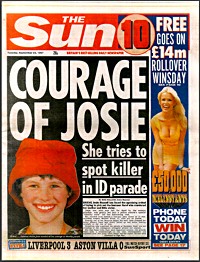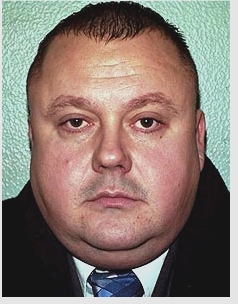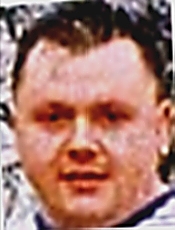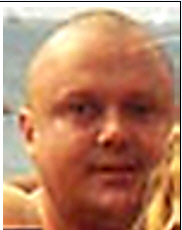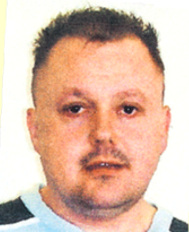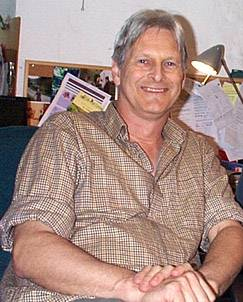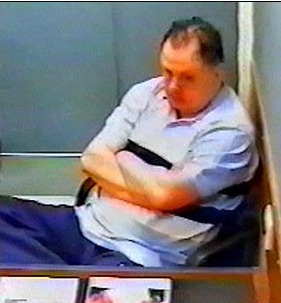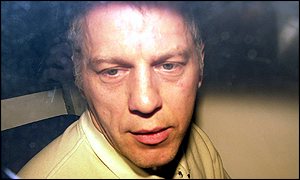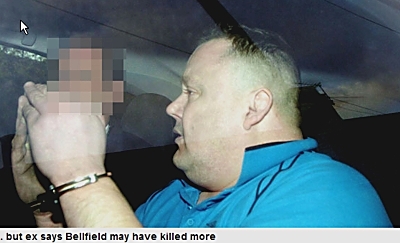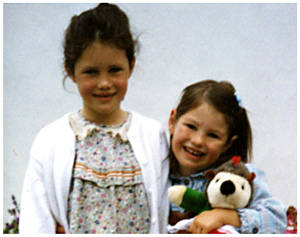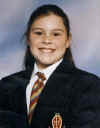Justice
Files |
|||
|
|||
Convicted of Murder"This is the most
horrific and terrible murder I have had the misfortune to come across "The nature of this
offence makes it almost unique." At about 4 pm on Tuesday 9th July 1996, after a swimming gala at a local school, Dr Lin Russell, then aged 45, and her two daughters Megan, aged 6, and Josie, aged 9, set off to walk home with their family dog. The walk should have taken about 45 minutes. At about 4.25 pm, as they were walking along Cherry Garden Lane, Chillenden, Kent, a quiet unmade track, they were attacked. Their attacker tied them up with torn towels and shoe laces, blindfolded them, and beat them over their heads with a hammer. Dr Lin Russell and Megan died, but although seriously injured, Josie survived. |
|||
|
|||
The Prosecution. "The evidence of the
main prosecution witness Damien Daley should not be dismissed Michael Stone was convicted of murder before two juries, but can a person ever receive a fair trial and be safely convicted on the strength of a confession which merely repeats facts that are in the public domain? He was arrested on 17th July 1997 just over a year following the crime as a result of a tip-off from his psychiatrist who said the police e-fit looked familiar. Stone denied any knowledge of the crime and was remanded in custody while an ID parade was arranged. On 23rd September 1997, following his request to the prison Governor to be moved to the segregation unit to 'escape from prisoners who were making up stories about his involvement in the crime', he was placed in a cell next to a heroin addict named Damien Daley, who later admitted in court to being an accomplished liar "in order to get by in life." In the evening Michael Stone (also a drug addict) allegedly confessed his guilt to Damien Daley by speaking through a gap between a heating pipe and their cell wall, which was reported to the police three days later, on the evening of 26th September. The Confession - 'spoken' by Michael Stone on 23rd September
1997
Daley Found Guilty of Murder 28 November 2014
The jury agreed that it would have been "like winning the lottery" for Damien Daley to have discovered the details of the crime "which only the murderer could have known" in the time available to him while inside Canterbury Prison; and accordingly Stone was found guilty. The jury heard that Daley had read some of the details in The Daily Mirror published on the day of the confession, but it was not told about when or where the remaining details had appeared - only that "they were either in the public domain, or capable of being inferred from material in the public domain." This clever admission by Mr Nigel Sweeney QC for the Crown was accepted by Mr William Clegg QC for the defence on the basis that it was made "in the context of there having been, prior to 23rd September 1997, publication of the Russell girls having attended a swimming gala on the day of the attack and that the defendant had tied the victims with strips of towel and it not having been possible to identify all media coverage prior to 23rd September 1997." The two barristers neglected to inform the jury that other details of the crime had appeared in the national press on the day of the confession (and possibly over the three days before Daley eventually reported the 'confession' on the evening of the 26th). The jury was also informed that other newspapers apart from the Daily Mirror were available to prisoners in the cell block - but they were not disclosed. During their retirement the jury sent the judge a note, specifically asking: "how much of the alleged confession is agreed to be in the pubic domain or deducible therefrom. eg. 'tries to run away', 'dog present' etc.?" They never received an answer to their question. The jurors were told they had to be sure Stone had confessed before they could convict, so they visited Canterbury prison and took turns to lie on a mattress in Daley's cell while extracts from a Harry Potter novel were read out from Stone's cell. The jurors could hear every word spoken through the hole which Daley had faithfully described, but they could not have suspected while cupping their ears to the wall that even if Stone had shouted out his confession from the rooftop, or had admitted his 'guilt' to the prison governor, his account of the crime would have been equally worthless. The Daily Mirror - published
on 23rd September 1997 The Daily Mail - published on
23rd September 1997 |
|||
| Daily Mail - 23/9/97 | The Times - 23/9/97 | Daily Mirror -23/9/97 | The Sun - 23/9/97 |
Trial Summary and Appeals Michael Stone said he was "fitted up by other prisoners", but experienced police officers and legal counsel (who should have known better) must accept responsibility for the consequences of turning a blind eye to newspaper articles published on the day of the alleged confession and for not showing those newspapers to the jury in two trials. Ms Anne Rafferty QC (now Mrs Justice Rafferty) told the jury that Mark Jennings, a convicted murderer, felt moved to testify against Stone because "his conscience had troubled him." It was "not because of a £5,000 reward" promised him by the Sun newspaper, with a further £10,000 to be paid if Stone was convicted. The learned QC added that "Stone was in the mood for killing. He is a tourniquet-using, E-fit resembling man with local knowledge of the area." Mr Nigel Sweeney QC (now Mr Justice Sweeney) told the Court of Appeal that Damien Daley - the 'hard man' of Canterbury Prison - "had been so upset by the horrific details he heard in the confession that he needed medical help" and was prescribed sleeping pills by a psychiatric nurse for a week after hearing Stone confess. It is not known what effect this submission had on their Lordships' judgement and whether they had to adjourn to regain their composure, but the consequences of naively accepting the word of prisoners while withholding evidence to gain a conviction meant that the search for the murderer ceased and other innocent victims would pay the price for the miscarriage of justice. Nobody in authority considered it remarkable that if Michael Stone's confession was genuine, it would indeed have been like winning the lottery, since it contained all six details of the crime which had ever been published - and no other details. Barry Thompson was one of the early prisoners who claimed Stone had confessed. He retracted his evidence post-trial and said: "None of what I said was true. They've put a man away for life for nothing, while the man who did it is still at large." |
|||
An 'agitated' man driving away from the crime scene had a "round red face with podgy cheeks and short gingery-blonde hair in a straight fringe. He was aged between 20-30yrs". (Levi Bellfield photos and witness descriptions). Several witnesses saw a "beige/butterscotch Ford Escort-style
family saloon" in the vicinity.
It is yet to be established whether Bellfield had adopted his 'blonde' look in July 1996, but family sources have confirmed that he used to bleach his hair regularly. His facial characteristics compared to the police E-fit merits further investigation regardless of his hair colour in the summer of 1996. The police said when issuing the e-fit: "make no mistake, this could be the murderer." If Josie Russell was right about the murderer's build and height- and she would know because she was in direct physical contact with him - this could explain why she was unable to pick out Michael Stone in an identity parade: she was looking for a much heavier and taller man - "like my father." Michael Stone was then 36yrs old and is 5' 7" tall. He was noticeably older, shorter and lighter than either Josie's father or Bellfield. His hair was receding and mid-brown and he does not have the telling features of "podgy cheeks", whereas Bellfield does. A single fingerprint impressed in blood was found on Josie Russell's green lunchbox and there was a suggestion that the perpetrator may have rummaged through the victims' belongings. That fingerprint did not belong to Stone, but the prosecution implied that it "could have been made" by Lin Russell, since she had a low loop count pattern on her right middle finger. Anne Rafferty QC said when deciding to prosecute Michael Stone that "he was not forensically
linked to the murder scene"
but "cases such
as these, in my experience, often shift a little, even a lot, as they progress. Albeit not
the strongest, there is a realistic prospect of a conviction, though it could easily
improve, and just as easily diminish, during a trial."
The use of a vehicle to stalk victims before attacking them with a hammer is a unique hallmark of Bellfield's modus operandi; and his predeliction for accosting school girls in uniforms is well established. In a separate case on 15th October 2001 - five years after this crime - 17 year old Anna-Marie Rennie gave a description of her attacker: He was about "6' 3" tall, 25 yrs old, with short blond hair and a round fat face." The man fitting this description turned out to be Levi Bellfield, who admitted to being at the scene of the attack although he blamed his friend for the assault. The question for the police to investigate is whether Bellfield was in the Chillenden area close to Canterbury in Kent on 9th July 1996. If he was not responsible for the Chillenden Murders then it means another 6' tall man with 'podgy' cheeks, "yellow hair" and a 'short, straight fringe' was also driving around with a hammer looking for schoolgirls to murder. The solution of this
crime will require a thorough forensic investigation rather than a reliance on a patently
bogus confession. Kent police may not be looking for anyone else and indeed
they stopped searching the moment they arrested Stone 14 years ago, but there is as much
chance of Michael Stone being the murderer as the judge who sentenced him.
LINKS A report by The
Honourable Fred Kaufman, C.M., Q.C. in regard to Jail Confessions which resulted in the
wrongful murder conviction NOTES: (i) March 1999 - The Guardian (15/3) - Mrs Batt refuses to speak to her daughter. "I disowned her because of her lying. If Mick done it, he wants cutting up in little pieces and put down a sewer. All right, he's a psycho but he didn't kill them. They had no forensics and people lied in the witness box for money. Me and my husband are the only two out of the whole lot who haven't sold our souls." (ii) Feb 2009 - A Scotland Yard task force is investigating Bellfield in relation to as many as 20 unsolved crimes, including murders, rapes, and a number of hammer assaults. These include the murder of Bellfield's school friend Patsy Morris, 14, who was strangled in Hounslow in 1980, as well as hammer attacks on women in south-west London in 1994 and 1996. There are also attacks in Blackpool, where Bellfield went on holiday, and in Sussex, where he worked. (iii) March 2010 - the CCRC have requested to examine the 99cm bootlace found at the scene of the crime which was dropped by the murderer while making his getaway. Such long laces (99 cm to 200 cm) are sold with hunting boots. Levi Bellfield used to go hunting. (iv) October 2010 - The CCRC have confirmed that the bootlace has been 'lost'. The Forensic Science Service state that they would have returned the whole lace to Kent Police in 1998, but when it was retrieved for further examination in 2010, only small fragments of previously examined lace remained, while the 80 cm long section of lace had been mislaid. (v) May 2011 Levi Bellfield has been tried for the attempted kidnapping of Rachel Cowles on 20th March 2002 and the murder of Milly Dowler on 21st March 2002 - as in the Chillenden Murders case, both girls were approached while they were walking home from school wearing school uniforms. CPS Announce Milly Dowler Charges (vi) 23rd June 2011 - Levi Bellfield is found guilty of the murder of Milly Dowler. (vii) 5th March 2012 - Kent police have provided authority to Mr Stone's defence team to examine the forensic case files held by the Forensic Science Service. (viii) 20th July 2012 - Kent police have reversed their decision to provide authority to access the DNA test results stored in the archives of the Forensic Science Service. The issue for the police and the CPS to address is that the primary exhibit in the case was a 1m long black bootlace which was dropped at the scene of the crime by the perpetrator. The lace was used to strangle Megan Russell. Multiple male DNA readings of D19 -12,14 were detected at various points along the lace, but that reading is not within Stone's profile. The CPS and the police suggested that the DNA must have come from one of Stone's fellow drug addicts while it was being used as a tourniquet; and that was why Stone's DNA was not on the lace, which was used to strangle Megan Russell. The same reading D19-12,14 was however detected at both ends of the girls' swimming towel, which was torn into six strips by the perpetrator. Male DNA of THO1- 6 was also detected on both ends of these strips. The last person to handle the black lace and the ends of the towelling strips was the perpetrator. These readings of D19 - 12,14 and THO1- 6 must therefore belong to the perpetrator's profile. They are not within Michael Stone's profile and therefore he could not have been the person who brought the lace to the crime scene and then dropped it while making his escape. He could also not have been the person who tore their swimming towel into strips, if the male DNA found on the ends of those strips belonged to the perpetrator. It is not feasible to ignore the significance of these DNA readings, which point towards an unknown assailant. An examination of test results obtained from other items handled by the perpetrator would enable further DNA readings in the perpetrator's profile to be determined. If the foregoing readings of D19-12,14 and THO1- 6 are within Mr Bellfield's profile then Kent police and the CPS have a clear duty to allow unfettered access to the DNA test reports for further appraisal. (ix) 14th April 2013 - A Judicial Review oral hearing is to take place in the High Court on 11th June 2013, which challenges the decision of Kent Police's refusal to allow access to the forensic case files. (x) 30th September 2013 - The JR application was refused as being "totally without merit" PDF (xi) 8th October 2013 - Mr Stone's legal team intend to present a fresh application to the CCRC on the basis of the DNA findings discovered on the towelling strips in 2010 using the low copy number DNA testing method.
|
|||

